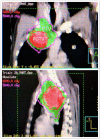Comparison of efficacy and safety between simultaneous integrated boost intensity-modulated radiotherapy and conventional intensity-modulated radiotherapy in locally advanced non-small-cell lung cancer: a retrospective study
- PMID: 31196118
- PMCID: PMC6567443
- DOI: 10.1186/s13014-019-1259-3
Comparison of efficacy and safety between simultaneous integrated boost intensity-modulated radiotherapy and conventional intensity-modulated radiotherapy in locally advanced non-small-cell lung cancer: a retrospective study
Abstract
Background: Consistent results are lacking as regards the comparative effectiveness of simultaneous integrated boost intensity-modulated radiotherapy (SIB-IMRT) versus conventional intensity-modulated radiotherapy in patients with locally advanced non-small-cell lung cancer (LA-NSCLC). Therefore, we conducted a retrospective analysis to demonstrate the role of SIB-IMRT for patients.
Methods: Patients who had histologically confirmed NSCLC, stage III disease and received thoracic IMRT between 2014 and 2016 were retrospectively reviewed. The survival, toxicities and dose to organs at risk (OAR) were compared among patients irradiated with different techniques. The SIB-IMRT plans were designed to deliver 45-59.4Gy (median: 50.4Gy) to PTV while simultaneously delivering 50-70Gy (median: 59.92Gy) to PGTV. As for conventional IMRT plans, a total dose of 50-70Gy (median: 60Gy) was delivered to PTV.
Results: 426 patients with stage III NSCLC were eligible for analysis, including 128 with SIB-IMRT and 298 with conventional IMRT. The SIB-IMRT group had more stage IIIB disease (69.5% vs. 53%, P = 0.002), larger planning treatment volumes (median: 504 ml vs. 402 ml, P<0.001), and a larger planning treatment volume/volume of lung ratio (median, 0.18 vs. 0.12, P<0.001). The median OS of the SIB-IMRT and conventional IMRT groups were 34.5 and 31.7 months, with the 2-year rate of 60.4 and 59%, respectively (P = 0.797). No difference in PFS, LRFS or DMFS was observed between the two techniques. Patients treated with SIB-IMRT got similar lung and esophageal toxicities versus those with conventional IMRT.
Conclusions: SIB-IMRT may be an effective and safe option for patients with locally advanced NSCLC, especially for those with large mass or wide lymph node metastasis.
Keywords: Intensity-modulated radiotherapy; Non-small cell lung cancer; Simultaneous integrated boost; Survival; Toxicity.
Conflict of interest statement
The authors declare that they have no competing interests.
Figures



Similar articles
-
Simultaneous integrated boost intensity-modulated radiotherapy for locally advanced non-small cell lung cancer in Chinese population: A retrospective study.Oncotarget. 2017 Jul 25;8(30):49084-49092. doi: 10.18632/oncotarget.17094. Oncotarget. 2017. PMID: 28467775 Free PMC article.
-
Is clinical target volume necessary for locally advanced non-small cell lung cancer treated with 4D-CT intensity-modulated radiation therapy.BMC Cancer. 2024 Sep 27;24(1):1198. doi: 10.1186/s12885-024-12979-z. BMC Cancer. 2024. PMID: 39334061 Free PMC article.
-
Intensity-Modulated Radiation Therapy May Improve Local-Regional Tumor Control for Locally Advanced Non-Small Cell Lung Cancer Compared With Three-Dimensional Conformal Radiation Therapy.Oncologist. 2016 Dec;21(12):1530-1537. doi: 10.1634/theoncologist.2016-0155. Epub 2016 Sep 14. Oncologist. 2016. PMID: 27628491 Free PMC article.
-
Intensity-modulated radiotherapy, not 3 dimensional conformal, is the preferred technique for treating locally advanced lung cancer.Semin Radiat Oncol. 2015 Apr;25(2):110-6. doi: 10.1016/j.semradonc.2014.11.002. Epub 2014 Nov 15. Semin Radiat Oncol. 2015. PMID: 25771415 Free PMC article. Review.
-
A comparison of clinical outcomes between simultaneous integrated boost (SIB) versus sequential boost (SEQ) intensity modulated radiation therapy (IMRT) for head and neck cancer: A meta-analysis.Medicine (Baltimore). 2019 Aug;98(34):e16942. doi: 10.1097/MD.0000000000016942. Medicine (Baltimore). 2019. PMID: 31441887 Free PMC article.
Cited by
-
GOECP/SEOR clinical recommendations for lung cancer radiotherapy during the COVID-19 pandemic.World J Clin Oncol. 2020 Aug 24;11(8):510-527. doi: 10.5306/wjco.v11.i8.510. World J Clin Oncol. 2020. PMID: 32879841 Free PMC article. Review.
-
Efficacy and Safety of Simultaneous Integrated Boost Intensity-Modulation Radiation Therapy Combined with Systematic and Standardized Management for Esophageal Cancer.Front Surg. 2022 May 23;9:905678. doi: 10.3389/fsurg.2022.905678. eCollection 2022. Front Surg. 2022. PMID: 35677748 Free PMC article.
-
A Special Report on 2019 International Planning Competition and a Comprehensive Analysis of Its Results.Front Oncol. 2020 Dec 4;10:571644. doi: 10.3389/fonc.2020.571644. eCollection 2020. Front Oncol. 2020. PMID: 33344231 Free PMC article.
-
Escalation of radiotherapy dose in large locally advanced drug-resistant gastrointestinal stromal tumors by multi-shell simultaneous integrated boost intensity-modulated technique: a feasibility study.Radiat Oncol. 2022 Dec 28;17(1):216. doi: 10.1186/s13014-022-02179-z. Radiat Oncol. 2022. PMID: 36578008 Free PMC article.
-
Targeting human epidermal growth factor receptor 2 enhances radiosensitivity and reduces the metastatic potential of Lewis lung carcinoma cells.Radiat Oncol. 2020 Mar 6;15(1):58. doi: 10.1186/s13014-020-01493-8. Radiat Oncol. 2020. PMID: 32143669 Free PMC article.
References
-
- Bezjak A, Temin S, Franklin G, et al. Definitive and adjuvant radiotherapy in locally advanced non-small-cell lung Cancer: American Society of Clinical Oncology clinical practice guideline endorsement of the American Society for Radiation Oncology evidence-based clinical practice guideline. J Clin Oncol. 2015;33:2100–2105. doi: 10.1200/JCO.2014.59.2360. - DOI - PubMed
-
- Liang J, Bi N, Wu S, et al. Etoposide and cisplatin versus paclitaxel and carboplatin with concurrent thoracic radiotherapy in unresectable stage III non-small cell lung cancer: a multicenter randomized phase III trial. Ann Oncol. 2017;28:777–783. - PubMed
-
- Wang J, Zhou Z, Liang J, et al. Intensity-modulated radiation therapy may improve local-regional tumor control for locally advanced non-small cell lung Cancer compared with three-dimensional conformal radiation therapy. Oncologist. 2016;21:1530–1537. doi: 10.1634/theoncologist.2016-0155. - DOI - PMC - PubMed
Publication types
MeSH terms
Grants and funding
LinkOut - more resources
Full Text Sources
Medical
Research Materials

